Highly Transparent and Surface-Plasmon-Enhanced Visible-Photodetector Based on Zinc Oxide Thin-Film Transistors with Heterojunction Structure
Abstract
1. Introduction
2. Materials and Methods
3. Results and Discussion
4. Conclusions
Supplementary Materials
Author Contributions
Funding
Conflicts of Interest
References
- Ahn, B.D.; Jeon, H.J.; Sheng, J.; Park, J.; Park, J.S. A review on the recent developments of solution processes for oxide thin film transistors. Semicond. Sci. Technol. 2015, 30, 064001. [Google Scholar] [CrossRef]
- Song, K.; Noh, J.; Jun, T.; Jung, Y.; Kang, H.Y.; Moon, J. Fully flexible solution-deposited ZnO thin-film transistors. Adv. Mater. 2010, 22, 4308–4312. [Google Scholar] [CrossRef] [PubMed]
- Xu, W.; Li, H.; Xu, J.B.; Wang, L. Recent Advances of Solution-Processed Metal Oxide Thin-Film Transistors. ACS Appl. Mater. Interfaces 2018, 10, acsami.7b16010. [Google Scholar] [CrossRef]
- Nam, S.; Yang, J.H.; Cho, S.H.; Choi, J.H.; Kwon, O.S.; Park, E.S.; Lee, S.J.; Cho, K.I.; Jang, J.; Hwang, C.S. Solution-processed indium-free ZnO/SnO 2 bilayer heterostructures as a low-temperature route to high-performance metal oxide thin-film transistors with excellent stabilities. J. Mater. Chem. C 2016, 4, 11298–11304. [Google Scholar] [CrossRef]
- Liu, X.; Wang, J.; Liao, C.; Xiao, X.; Guo, S.; Jiang, C.; Fan, Z.; Wang, T.; Chen, X.; Lu, W.; et al. Transparent, high-performance thin-film transistors with an InGaZnO/Aligned-SnO2-nanowire composite and their application in photodetectors. Adv. Mater. 2014, 26, 7399–7404. [Google Scholar] [CrossRef] [PubMed]
- Ahn, C.H.; Kang, W.J.; Kim, Y.K.; Yun, M.G.; Cho, H.K. Highly Repeatable and Recoverable Phototransistors Based on Multifunctional Channels of Photoactive CdS, Fast Charge Transporting ZnO, and Chemically Durable Al2O3 Layers. ACS Appl. Mater. Interfaces 2016, 22, 15518–15523. [Google Scholar] [CrossRef] [PubMed]
- Yu, J.; Javaid, K.; Liang, L.; Wu, W.; Liang, Y.; Song, A.; Zhang, H.; Shi, W.; Chang, T.C.; Cao, H. High-Performance Visible-Blind Ultraviolet Photodetector Based on IGZO TFT Coupled with p-n Heterojunction. ACS Appl. Mater. Interfaces 2018, 10, 8102–8109. [Google Scholar] [CrossRef] [PubMed]
- Choi, H.; Seo, S.; Lee, J.H.; Hong, S.H.; Song, J.; Kim, S.; Yim, S.Y.; Lee, K.; Park, S.J.; Lee, S. Solution-processed ZnO/SnO2 bilayer ultraviolet phototransistor with high responsivity and fast photoresponse. J. Mater. Chem. C 2018, 6, 6014–6022. [Google Scholar] [CrossRef]
- Thepnurat, M.; Chairuangsri, T.; Hongsith, N.; Ruankham, P.; Choopun, S. Realization of Interlinked ZnO Tetrapod Networks for UV Sensor and Room-Temperature Gas Sensor. ACS Appl. Mater. Interfaces 2015, 7, 24117–24184. [Google Scholar] [CrossRef] [PubMed]
- Cao, F.; Tian, W.; Gu, B.; Ma, Y.; Lu, H.; Li, L. High-performance UV–vis photodetectors based on electrospun ZnO nanofiber-solution processed perovskite hybrid structures. Nano Res. 2017, 10, 2244–2256. [Google Scholar] [CrossRef]
- Liu, X.; Gu, L.; Zhang, Q.; Wu, J.; Long, Y.; Fan, Z. All-printable band-edge modulated ZnO nanowire photodetectors with ultra-high detectivity. Nat. Commun. 2014, 5, 1–9. [Google Scholar] [CrossRef] [PubMed]
- Gong, M.; Liu, Q.; Cook, B.; Kattel, B.; Wang, T.; Chan, W.L.; Ewing, D.; Casper, M.; Stramel, A.; Wu, J.Z. All-Printable ZnO Quantum Dots/Graphene van der Waals Heterostructures for Ultrasensitive Detection of Ultraviolet Light. ACS Nano 2017, 11, 4114–4123. [Google Scholar] [CrossRef] [PubMed]
- Jing, W.; Ding, N.; Li, L.; Jiang, F.; Xiong, X.; Liu, N.; Zhai, T.; Gao, Y. Ag nanoparticles modified large area monolayer MoS_2 phototransistors with high responsivity. Opt. Express 2017, 25, 14565. [Google Scholar] [CrossRef] [PubMed]
- Shin, S.W.; Lee, K.H.; Park, J.S.; Kang, S.J. Highly Transparent, Visible-Light Photodetector Based on Oxide Semiconductors and Quantum Dots. ACS Appl. Mater. Interfaces 2015, 7, 19666–19671. [Google Scholar] [CrossRef] [PubMed]
- Wu, Z.Q.; Yang, J.L.; Manjunath, N.K.; Zhang, Y.J.; Feng, S.R.; Lu, Y.H.; Wu, J.H.; Zhao, W.W.; Qiu, C.Y.; Li, J.F.; et al. Gap-Mode Surface-Plasmon-Enhanced Photoluminescence and Photoresponse of MoS2. Adv. Mater. 2018, 30, 1–7. [Google Scholar] [CrossRef] [PubMed]
- Li, Z.; Xiao, Y.; Gong, Y.; Wang, Z.; Kang, Y.; Zu, S.; Ajayan, P.M.; Nordlander, P.; Fang, Z. Active Light Control of the MoS2 Monolayer Exciton Binding Energy. ACS Nano 2015, 9, 10158–10164. [Google Scholar] [CrossRef] [PubMed]
- Wu, K.; Rodríguez-Córdoba, W.E.; Yang, Y.; Lian, T. Plasmon-induced hot electron transfer from the Au tip to CdS rod in CdS-Au nanoheterostructures. Nano Lett. 2013, 13, 5255–5263. [Google Scholar] [CrossRef]
- Yang, Z.; Liu, M.; Liang, S.; Zhang, W.; Mei, T.; Zhang, D.; Chua, S.J. Hybrid modes in plasmonic cavity array for enhanced hot-electron photodetection. Opt. Express 2017, 25, 20268. [Google Scholar] [CrossRef]
- Kojori, H.S.; Yun, J.H.; Paik, Y.; Kim, J.; Anderson, W.A.; Kim, S.J. Plasmon Field Effect Transistor for Plasmon to Electric Conversion and Amplification. Nano Lett. 2016, 16, 250–254. [Google Scholar] [CrossRef]
- Kim, J.; Park, C.J.; Yi, G.; Choi, M.S.; Park, S.K. Low-temperature solution-processed gate dielectrics for high-performance organic thin film transistors. Materials 2015, 8, 6926–6934. [Google Scholar] [CrossRef]
- Cai, W.; Zhu, Z.; Wei, J.; Fang, Z.; Ning, H.; Zheng, Z.; Zhou, S.; Yao, R.; Peng, J.; Lu, X. A simple method for high-performance, solution-processed, amorphous ZrO2 gate insulator TFT with a high concentration precursor. Materials 2017, 10, 972. [Google Scholar] [CrossRef] [PubMed]
- Qin, Y.; Su, J.; Wan, L.; He, F.; Hao, Y.; Lin, Z.; Chang, J. Effects of Interfacial Passivation on the Electrical Performance, Stability, and Contact Properties of Solution Process Based ZnO Thin Film Transistors. Materials 2018, 11, 1761. [Google Scholar]
- Ji, S.Y.; Choi, W.; Kim, H.Y.; Jeon, J.W.; Cho, S.H.; Chang, W.S. Fully solution-processable fabrication of multi-layered circuits on a flexible substrate using laser processing. Materials 2018, 11, 268. [Google Scholar] [CrossRef] [PubMed]
- Wang, C.J.; You, H.C.; Ko, F.H. The highly electrical performances of flexible indium-zinc-oxide based thin-film transistors on stability improvement by passivation layer. Microelectron. Eng. 2017, 177, 87–92. [Google Scholar] [CrossRef]
- You, H.C.; Wang, C.J. Low-temperature, solution-processed, transparent zinc oxide-based thin-film transistors for sensing various solvents. Materials 2017, 10, 234. [Google Scholar] [CrossRef]
- Ning, H.; Chen, J.; Fang, Z.; Tao, R.; Cai, W.; Yao, R.; Hu, S.; Zhu, Z.; Zhou, Y.; Yang, C.; et al. Direct inkjet printing of silver source/drain electrodes on an amorphous InGaZnO layer for thin-film transistors. Materials 2017, 10, 51. [Google Scholar] [CrossRef]
- Lee, H.; Zhang, X.; Hwang, J.; Park, J. Morphological influence of solution-processed zinc oxide films on electrical characteristics of thin-film transistors. Materials 2016, 9, 851. [Google Scholar]
- Rao, M.G.S.; Sánchez-Martinez, A.; Gutiérrez-Heredia, G.; Quevedo-López, M.A.; Ramírez-Bon, R. Sol-gel derived low temperature HfO2-GPTMS hybrid gate dielectric for a-IGZO thin-film transistors (TFTs). Ceram. Int. 2018, 44, 16428–16434. [Google Scholar] [CrossRef]
- Ozden, B.; Sk, M.H.; Park, M.; Khanal, M.P.; Sultan, M.S.; Hamilton, M.C.; Ahyi, A.C.; Yapabandara, K.; Uprety, S.; Wang, S.; et al. On the anomaly in the electrical characteristics of thin film transistors with multi-layered sol-gel processed ZnO. Thin Solid Films 2019, 672, 152–156. [Google Scholar]
- Kwon, Y.J.; Park, Y.D.; Lee, W.H. Inkjet-printed organic transistors based on organic semiconductor/insulating polymer blends. Materials 2016, 9, 650. [Google Scholar] [CrossRef]
- Zeumault, A.; Scheideler, W.; Subramanian, V. Electrostatic Tuning of Spray-Deposited ZnO for Controlled Mobility Enhancement. Adv. Funct. Mater. 2017, 27, 1–10. [Google Scholar] [CrossRef]
- Sayed, M.H.; Robert, E.V.C.; Dale, P.J.; Gütay, L. Cu2SnS3 based thin film solar cells from chemical spray pyrolysis. Thin Solid Films 2019, 669, 436–439. [Google Scholar] [CrossRef]
- Naveena, D.; Logu, T.; Dhanabal, R.; Sethuraman, K.; Bose, A.C. Comparative study of effective photoabsorber CuO thin films prepared via different precursors using chemical spray pyrolysis for solar cell application. J. Mater. Sci. Mater. Electron. 2019, 30, 561–572. [Google Scholar] [CrossRef]
- Isakov, I.; Faber, H.; Grell, M.; Wyatt-Moon, G.; Pliatsikas, N.; Kehagias, T.; Dimitrakopulos, G.P.; Patsalas, P.P.; Li, R.; Anthopoulos, T.D. Exploring the Leidenfrost Effect for the Deposition of High-Quality In2O3 Layers via Spray Pyrolysis at Low Temperatures and Their Application in High Electron Mobility Transistors. Adv. Funct. Mater. 2017, 27, 1–9. [Google Scholar] [CrossRef]
- Liu, H.Y.; Hung, C.C.; Hsu, W.C. Deposition of Oxide Thin Films by Ultrasonic Spray Pyrolysis Deposition for InGaZnO Thin-Film Transistor Applications. IEEE Electron Device Lett. 2018, 39, 1520–1523. [Google Scholar]
- Mostafa, N.Y.; Badawi, A.; Ahmed, S.I. Influence of Cu and Ag doping on structure and optical properties of In2O3thin film prepared by spray pyrolysis. Results Phys. 2018, 10, 126–131. [Google Scholar] [CrossRef]
- Yang, B.X.; Chien, Y.H.C.; Chang, T.; Liao, C.H.; Liu, C.Y.; Chiang, A.S.T.; Liu, C.L. Fully Solution-Processed Low-Voltage Driven Transparent Oxide Thin Film Transistors. Status Solidi A Appl. Mater. 2018, 215, 1800192. [Google Scholar] [CrossRef]
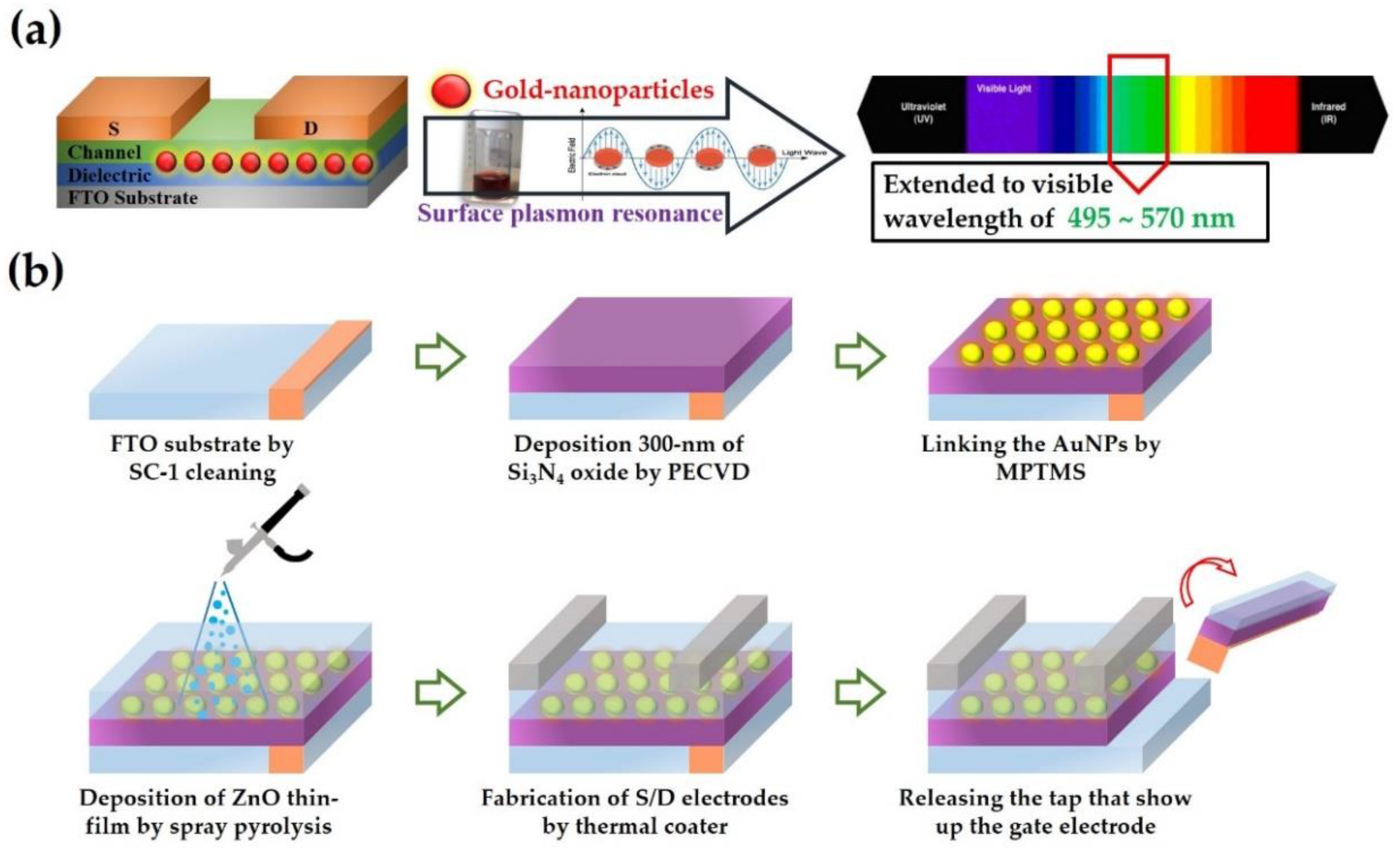
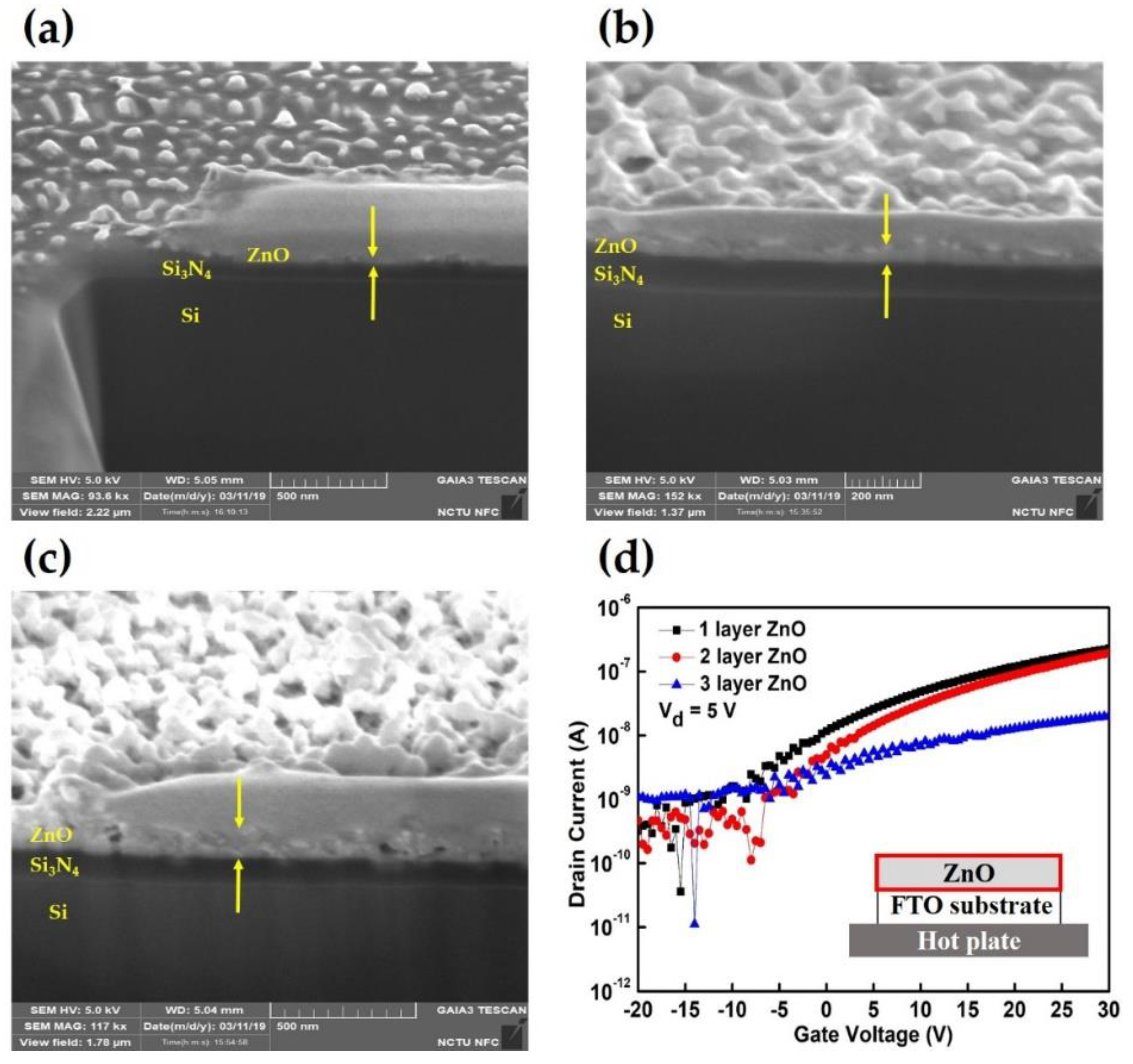
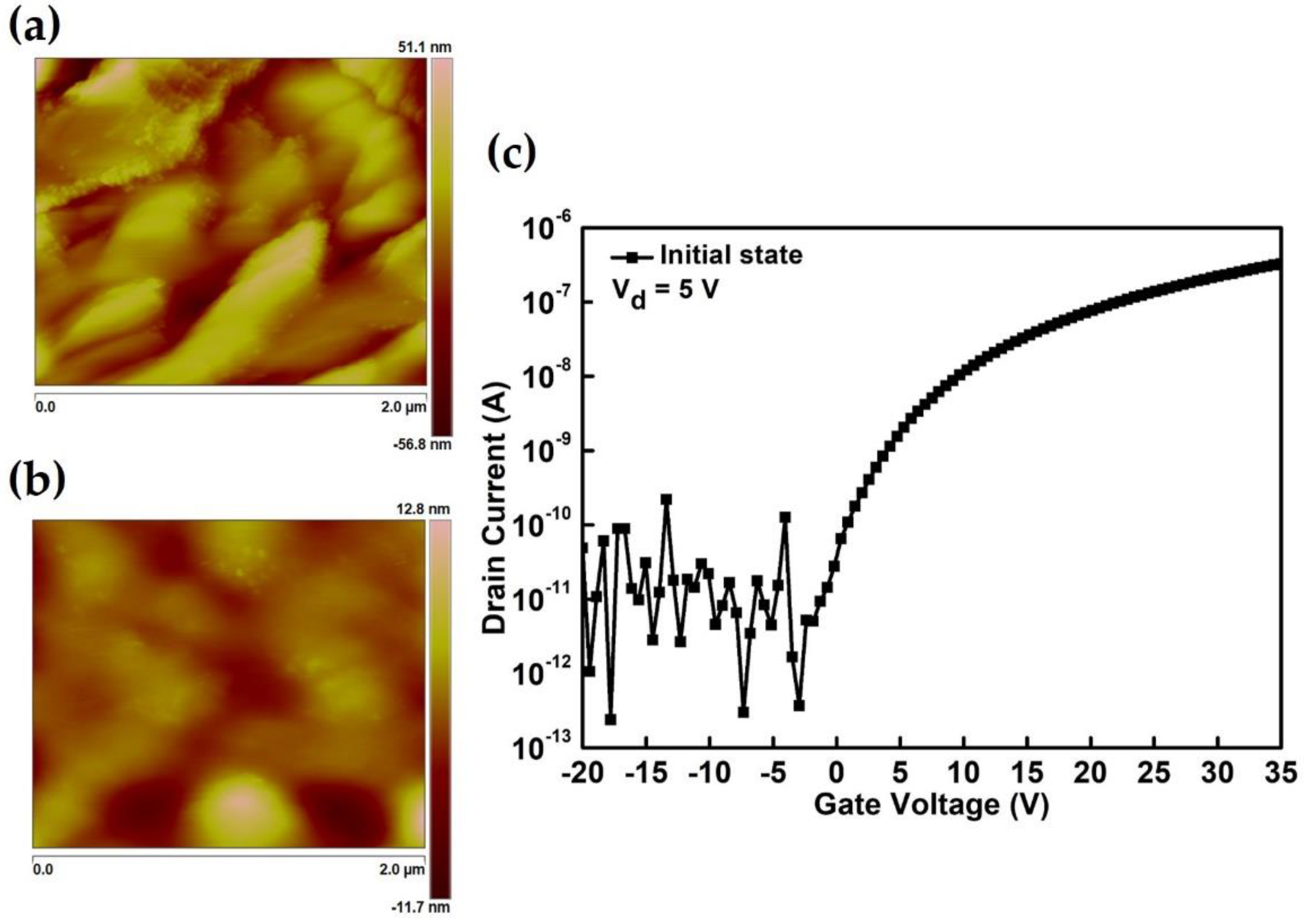
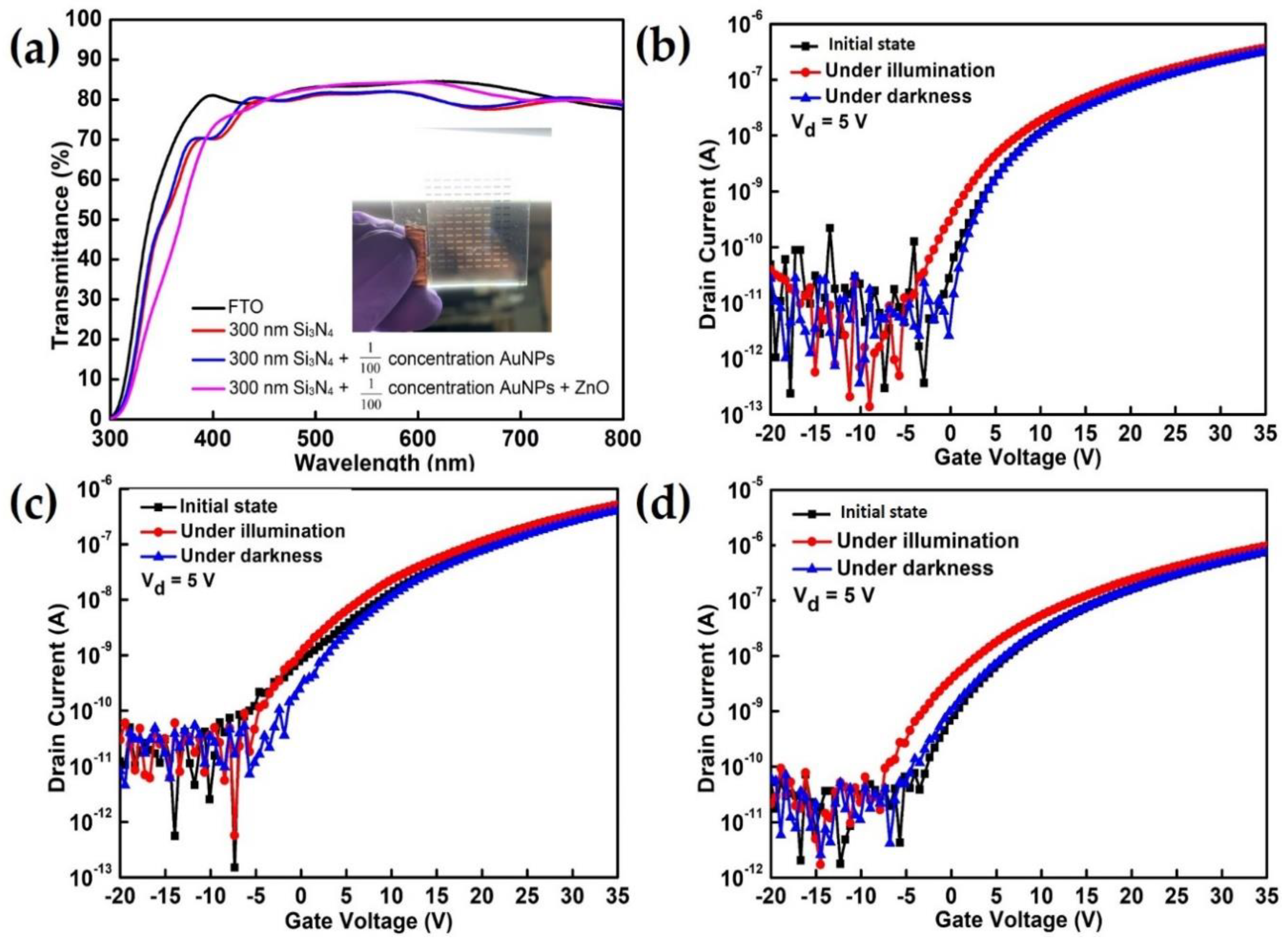
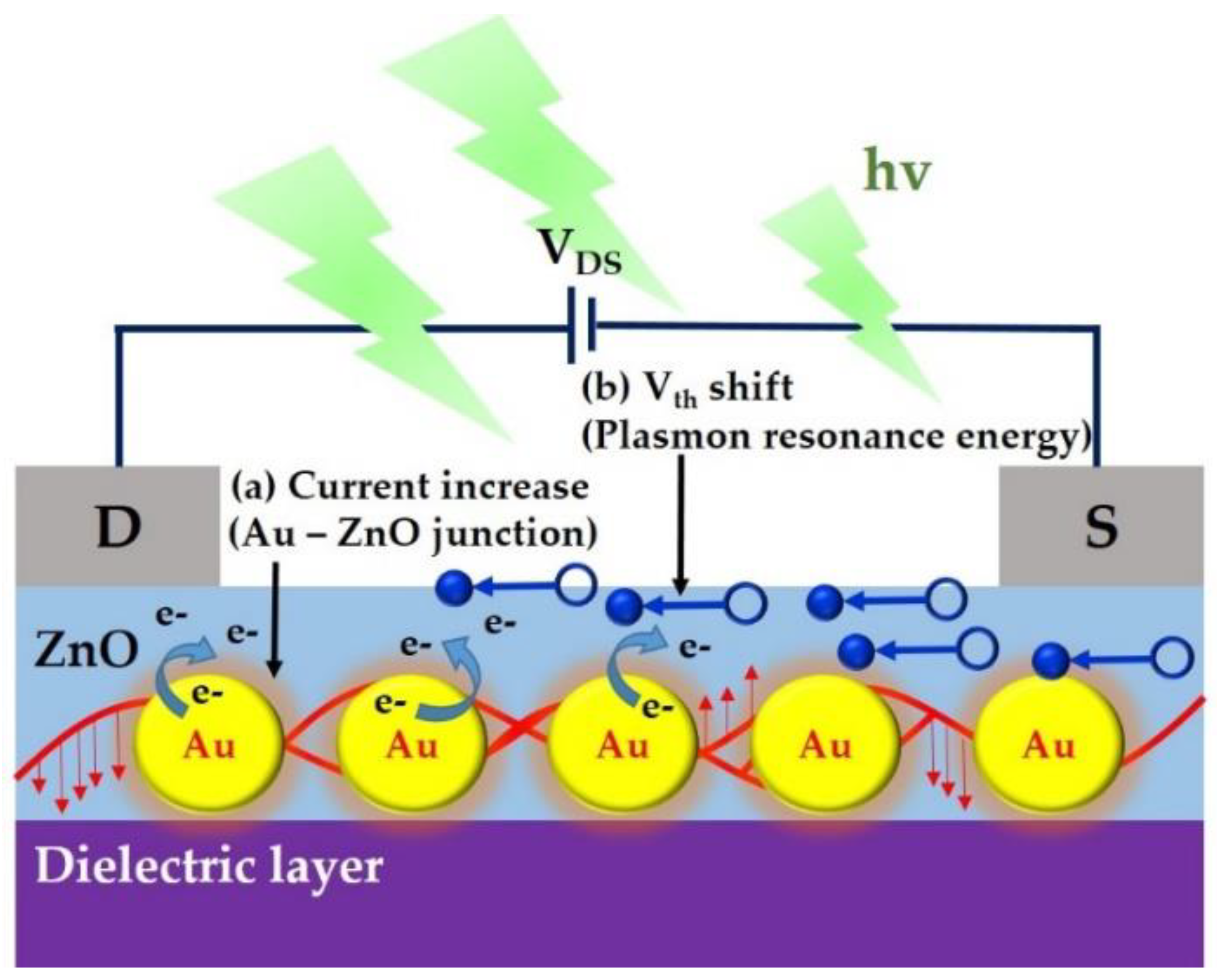
© 2019 by the authors. Licensee MDPI, Basel, Switzerland. This article is an open access article distributed under the terms and conditions of the Creative Commons Attribution (CC BY) license (http://creativecommons.org/licenses/by/4.0/).
Share and Cite
Wang, C.-J.; You, H.-C.; Lin, K.; Ou, J.-H.; Chao, K.-H.; Ko, F.-H. Highly Transparent and Surface-Plasmon-Enhanced Visible-Photodetector Based on Zinc Oxide Thin-Film Transistors with Heterojunction Structure. Materials 2019, 12, 3639. https://doi.org/10.3390/ma12213639
Wang C-J, You H-C, Lin K, Ou J-H, Chao K-H, Ko F-H. Highly Transparent and Surface-Plasmon-Enhanced Visible-Photodetector Based on Zinc Oxide Thin-Film Transistors with Heterojunction Structure. Materials. 2019; 12(21):3639. https://doi.org/10.3390/ma12213639
Chicago/Turabian StyleWang, Cheng-Jyun, Hsin-Chiang You, Kuan Lin, Jen-Hung Ou, Keng-Hsien Chao, and Fu-Hsiang Ko. 2019. "Highly Transparent and Surface-Plasmon-Enhanced Visible-Photodetector Based on Zinc Oxide Thin-Film Transistors with Heterojunction Structure" Materials 12, no. 21: 3639. https://doi.org/10.3390/ma12213639
APA StyleWang, C.-J., You, H.-C., Lin, K., Ou, J.-H., Chao, K.-H., & Ko, F.-H. (2019). Highly Transparent and Surface-Plasmon-Enhanced Visible-Photodetector Based on Zinc Oxide Thin-Film Transistors with Heterojunction Structure. Materials, 12(21), 3639. https://doi.org/10.3390/ma12213639




